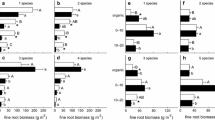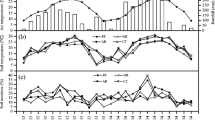Abstract
Background and aims
Belowground interactions can greatly modify fine root (≤2 mm in diameter) traits to increase soil resource acquisition for tree growth. We examined how mixed forests alter fine root traits compared to pure forests.
Methods
A pseudo-experimental tree cluster design was used to select small-area plots of single and mixed species in a Pinus massoniana–Lithocarpus glaber (PM–LG) forest and a L. glaber–Cyclobalanopsis glauca (LG–CG) forest. In each plot, soil cores were sampled down to 30 cm at a 0.5 m interval between target and neighbouring trees. Fine roots in soil cores were then divided by species to determine biomass and morphological traits.
Results
The mixed PM–LG plots exhibited significantly higher fine root biomass while the mixed LG–CG plots had no significant differences in fine root biomass compared to their respective pure plots. In pure plots, P. massoniana had higher fine root biomass and lower specific root length (SRL) and specific root area (SRA) than L. glaber, whereas fine root traits were similar for L. glaber and C. glauca. Compared with pure plots for a given species, fine root biomass in the entire soil profile decreased for P. massoniana but increased for L. glaber in mixed PM–LG plots. In mixed LG–CG plots, fine root biomass decreased for each species at all soil depths.
Conclusions
Whether positive interactions of fine roots occur is dependent on tree species composition. Fine root biomass was greater in mixed forests where tree species showed contrasting growth strategies and root traits, such as PM-LG forests, thus suggesting positive interactions.







Similar content being viewed by others
References
Bauhus J, Messier C (1999) Soil exploitation strategies of fine roots in different tree species of the southern boreal forest of eastern Canada. Can J For Res 29:260–273
Bauhus J, Khanna PK, Menden N (2000) Aboveground and below ground interactions in mixed plantations of Eucalyptus globulus and Acacia mearnsii. Can J For Res 30:1886–1894
Bennett JN, Andrew B, Prescott CE (2002) Vertical fine root distributions of western redcedar, western hemlock, and salal in old-growth cedar-hemlock forests on northern Vancouver Island. Can J For Res 32:1208–1216
Berendse F (1979) Competition between plant-populations with different rooting depths.1. Theoretical considerations. Oecologia 43:19–26
Binkley D (2003) Seven decades of stand development in mixed and pure stands of conifers and nitrogen-fixing red alder. Can J For Res 33:2274–2279
Bolte A, Villanueva I (2006) Interspecific competition impacts on the morphology and distribution of fine roots in European beech (Fagus sylvatica L.) and Norway spruce (Picea abies (L.) Karst.). Eur J For Res 125:15–26
Børja I, DeWit HA, Steffenrem A, Majdi H (2008) Stand age and fine root biomass, distribution and morphology in a Norway spruce chronosequence in southeast Norway. Tree Physiol 28:773–784
Brassard BW, Chen HYH, Bergeron YB (2009) Influence of environmental variability on root dynamics in northern forests. Crit Rev Plant Sci 28:179–197
Brassard BW, Chen HYH, Bergeron Y, Paré D (2011) Differences in fine root productivity between mixed- and single-species stands. Funct Ecol 25:238–246
Brassard BW, Chen HYH, Cavard X, Laganiere J, Reich PB, Bergeron Y, Paré Yuan ZY (2013) Tree species diversity increases fine root productivity through increased soil volume filling. J Ecol 101:210–219
Callaway RM (1995) Positive interactions among plants. Bot Rev 61:306–349
Campbell BD, Grime JP, Mackey JML, Jalili A (1991) The quest of a mechanistic understanding of resource competition in plant communities: the role of experiments. Funct Ecol 5:241–253
Cardinale BJ, Srivastava DS, Duffy JE, Wright JP, Downing AL, Sankaran M, Jouseau C (2006) Effects of biodiversity on the functioning of trophic groups and ecosystems. Nature 443:989–992
Casper BB, Jackson RB (1997) Plant competition underground. Annu Rev Ecol Syst 28:545–570
Curt T, Prévosto B (2003) Rooting strategy of naturally regenerated beech in silver birch and Scots pine woodlands. Plant Soil 255:265–279
da Silva EV, Gonçalves JLM, Coelho SRF, Moreira RM, Mello SLM, Bouillet J-P, Jourdan C, Laclau J-P (2009) Dynamics of fine root distribution after establishment of monospecific and mixed-species plantations of Eucalyptus grandis and Acacia mangium. Plant Soil 325:305–318
de Kroon H (2007) How do roots interact? Science 318(7):1562–1563
Falik O, Reides P, Gersani M, Novoplansky A (2003) Self/non-self discrimination in roots. J Ecol 91:525–531
Fitter AH (1991) Characteristics and functions of root systems. In: Waisel Y, Eshel A, Kafkafi U (eds) Plant roots: the hidden half. Marcel Dekker, New York, pp 15–32
Forrester DI (2014) The spatial and temporal dynamics of species interactions in mixed-species forests: From pattern to process. For Ecol Manage 312:282–292
Forrester DI, Bauhus J, Cowie AL, Vanclay JK (2006) Mixed-species plantations of Eucalyptus with nitrogen fixing trees: a review. For Ecol Manage 233:211–230
Fredericksen TS, Zedaker SM (1995) Fine root biomass, distribution, and production in young pine-hardwood stands. New For 10:99–110
Fridley JD (2001) The influence of species diversity on ecosystem productivity: how, where, and why? Oikos 93:514–526
Fujii S, Kasuya N (2008) Fine root biomass and morphology of Pinus densiflora under competitive stress by Chamaecyparis obtusa. J For Res 13(3):185–189
Gamfeldt L, Snäll T, Bagchi R, Jonsson M, Gustafsson L, Kjellander P, Ruiz-Jaen MC, Fröberg M, Stendahl J, Philipson CD, Mikusiński G, Andersson E, Westerlund B, Andrén H, Moberg F, Moen J, Bengtsson J (2013) Higher levels of multiple ecosystem services are found in forests with more tree species. Nat Commun 4:1340
Grams TEE, Kozovits AR, Winkler JB, Sommerkorn M, Blaschke H, Häberle K-H, Matyssek R (2002) Quantifying competitive trees in woody plants. Plant Biol 4:153–158
IUSS Working Group WRB (2006) World Reference Base for Soil Resource 2006. In: World Soil Resources Reports No. 103. second ed. FAO, Rome
Jacob A, Hertel D, Leuschner C (2013) On the significance of belowground overyielding in temperate mixed forests: separating species identity and species diversity effects. Oikos 122:463–473
Jacob A, Hertel D, Leuschner C (2014) Diversity and species identity effects on fine root productivity and turnover in a species-rich temperate broad-leaved forest. Funct Plant Biol 41(7):678–689
Kalliokoski T, Pennanen T (2010) Belowground interspecific competition in mixed boreal forests: fine root and ectomycorrhiza characteristics along stand developmental stage and soil fertility gradients. Plant Soil 330:73–89
Knoke T, Ammer C, Stimm B, Mosandl R (2008) Admixing broadleaved to coniferous tree species: a review on yield, ecological stability and economics. Eur J For Res 127:89–101
Laclau JP, Nouvellon Y, Reine C, Goncąlves JLM, Krushe AV, Jourdan C, Maire G, Bouillet JP (2013) Mixing Eucalyptus and Acacia trees leads to fine root over-yielding and vertical segregation between species. Oecologia 172:903–913
Lei PF, Scherer-Lorenzen M, Bauhus J (2012) Belowground facilitation and competition in young tree species mixtures. For Ecol Manage 265:191–200
Leuschner C, Hertel D, Coners H, Büttner V (2001) Root competition between beech and oak: a hypothesis. Oecologia 126:276–284
Liu C, Xiang W, Lei P, Deng X, Tian D, Fang X, Peng C (2014) Standing fine root mass and production in four Chinese subtropical forests along a succession and species diversity gradient. Plant Soil 376:445–459
Meinen C, Hertel D, Leuschner C (2009) Biomass and morphology of fine roots in temperate broad-leaved forests differing in tree species diversity: is there evidence of below-ground overyielding? Oecologia 161:99–111
Messier C, Coll L, Poitras-Larivière A, Bélanger N, Brisson J (2009) Resource and non-resource root competition effects of grasses on early- versus late-successional trees. J Ecol 97:548–554
Pregitzer KS, Deforest JL, Burton AJ, Allen ME, Ruess RW, Hendrick RL (2002) Fine root architecture of nine north American trees. Ecol Monogr 72(2):293–309
Qi CJ (1990) Hunan vegetation. Hunan Science and Technology Press, Changsha, China (in Chinese)
Rewald B, Leuschner C (2009) Belowground competition in a broad-leaved temperate mixed forest: pattern analysis and experiments in a four-species stand. Eur J For Res 128:387–398
Rysavy T, Roloff A (1994) Ursachen der Vereschung in Mischbeständen und Vorschläge zu ihrer Vermeidung. Forst und Holz 49:392–395
SAS Institute (1996) JMP start statistics – A guide to statistics and data analysis using JMP and JMP IN software. Duxbury Press, Belmont
Schenk HJ (2006) Root competition: beyond resource depletion. J Ecol 94:725–739
Schmid I (2002) The influence of soil type and interspecific competition on the fine root system of Norway spruce and European beech. Basic Appl Ecol 3:339–346
Schmid I, Kazda M (2002) Root distribution of Norway spruce in monospecific and mixed stands on different soil. For Ecol Manage 159:37–47
Schmid B, Hector A, Saha P, Loreau M (2008) Biodiversity effects and transgressive overyielding. J Plant Ecol 1:95–102
Silver WL, Thompson AW, McGroddy ME, Varner RK, Dias JD, Silva H, Crill PM, Kellers M (2005) Fine root dynamics and trace gas fluxes in two lowland tropical forest soils. Glob Change Biol 11:290–360
Tong J, Xiang WH, Liu C, Lei PF, Tian DL, Deng XW, Peng CH (2012) Tree species effects on fine root decomposition and nitrogen release in subtropical forests in southern China. Plant Ecol Divers 3:323–331
Vandermeer J (1989) The ecology of intercropping. Cambridge University Press, Cambridge
Vilà M, Carrillo-Gavilán A, Vayreda J, Bugmann H, Fridman J, Grodzki W, Haase J, Kunstler G, Schelhaas M, Trasobares A (2013) Disentangling biodiversity and climatic determinants of wood production. PLoS One 8:e53530
Wang XL, Klinka K, Chen HYH, de Montigny L (2002) Root structure of western hemlock and western redcedar in single- and mixed-species stands. Can J For Res 34:997–1004
Xiang W, Wu W, Tong J, Deng X, Tian D, Zhang L, Liu C, Peng C (2013) Differences in fine root traits between early and late-successional tree species in a Chinese subtropical forest. Forestry 86(3):343–351
Yuan ZY, Chen HYH (2010) Fine root biomass, production, turnover rates, and nutrient contents in boreal forest ecosystems in relation to species, climate, fertility, and stand age: literature review and meta-analyses. Crit Rev Plant Sci 29:204–221
Yuan ZY, Chen HYH (2012) Fine root dynamics with stand development in the boreal forest. Funct Ecol 26:991–998
Zhang YH, Chen HYH, Reich PB (2012) Forest productivity increases with evenness, species richness and trait variation: a global meta-analysis. J Ecol 100:742–749
Acknowledgments
This study was funded by the National Natural Science Foundation of China (31170426 and 30771720), the New Century Excellent Talents Program (NCET-06-0715), and the Program for Science and Technology Innovative Research Teams in Higher Educational Institutions of Hunan Province. The authors thank Dr David Forrester for his valuable comments and language editing on the manuscript.
Author information
Authors and Affiliations
Corresponding author
Additional information
Responsible Editor: Etienne Laliberté.
Electronic supplementary material
Below is the link to the electronic supplementary material.
ESM 1
(DOC 93 kb)
Rights and permissions
About this article
Cite this article
Xiang, W., Fan, G., Lei, P. et al. Fine root interactions in subtropical mixed forests in China depend on tree species composition. Plant Soil 395, 335–349 (2015). https://doi.org/10.1007/s11104-015-2573-7
Received:
Accepted:
Published:
Issue Date:
DOI: https://doi.org/10.1007/s11104-015-2573-7




